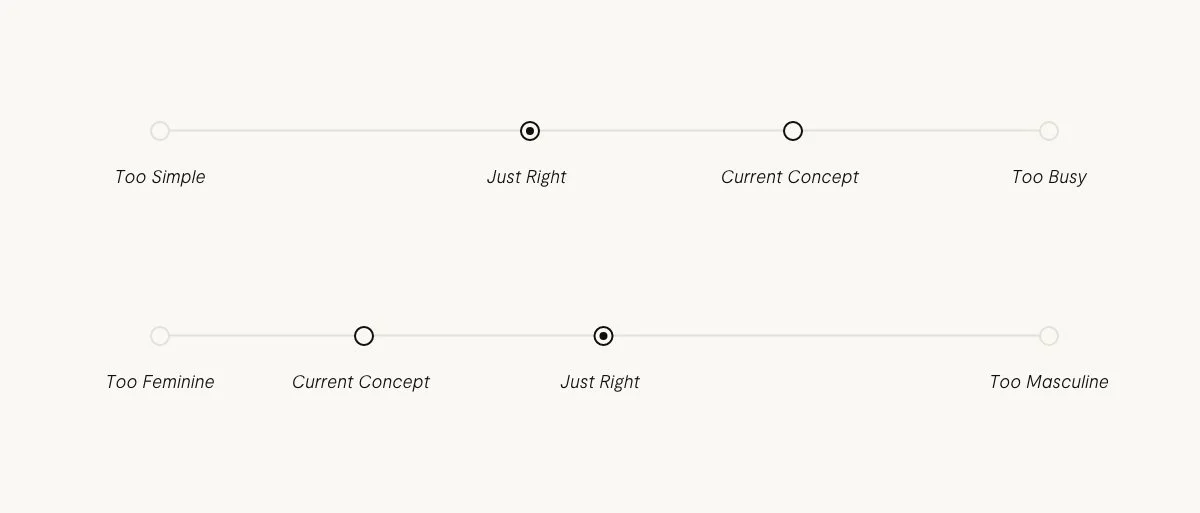Feedback Guide
If you’re finding it difficult to provide feedback on presentations, don’t worry – you aren’t alone ❤️
Giving feedback on creative concepts can be hard sometimes! As a designer, I’ve had a lot of practice thinking strategically about design concepts and talking about what works vs. what doesn’t and why. But as a non-designer, having these types of conversations might feel new to you and that’s ok. Below are some tips and tricks that will hopefully make the feedback process feel easier for you.
And if you still find yourself struggling to explain your feedback, remember that you always have the option to schedule a review call with me so we can talk through presentations together. For some clients, review calls end up being easier and more productive, so that’s why I always offer them as an option.
Tip No. 01 – Be as specific as possible.
When talking about design or creative concepts, vague answers like “It’s not working” or “I just don’t like it” aren’t very helpful for me because it doesn’t help me understand what specific elements of the concept need to be refined. So when giving your feedback, it’s important to be specific and explain WHY something feels good or bad to you! This can sometimes be hard to put your finger on or explain in words, but try your best.
Tip No. 02 – Use the Goldilocks exercise when you know that something needs to change, but you aren’t sure what that change should be.
This problem comes up often with clients! They like a concept and it feels 80% of the way there, but there’s something missing and they don’t know what it is. In these situations, I like to do the Goldilocks exercise! (Yes, like the kid’s story of Goldilocks and 3 bears)
In that story, Goldilocks tries different bowls of porridge. Some are too hot, some are too cold. But Goldilocks wants to find the one that’s just right.
So imagine if there was a spectrum that Goldilocks could use to rank a bowl of porridge. One end of the spectrum is for the “Too Hot” bowls and the other end is for the “Too Cold” bowls.
We want to use a similar idea to figure out what isn’t working with the current design concept and what direction it needs to move on the spectrum to feel “just right”.
You’ll choose different adjectives for the opposite ends of the spectrum, likely ones that relate to how you want your brand to be perceived vs. how you don’t want to be perceived. Then you’ll figure out where you feel the current concept is on that spectrum and where you want it to be instead so that it will feel “just right”. Below are a few examples:
You can try doing this exercise on your own or ask me to help you with it during a review call! The easiest way to start is by simply asking yourself: “Does this concept feel too ___________ or too ___________ to me?”
Tip No. 03 – Always consider your audience’s point of view + be mindful of your own personal preferences.
You likely feel a very personal connection to your business and that passion is definitely something that we want to convey through the work. But sometimes business owners can prioritize their own personal preferences over what’s really going to be the most strategic solution for their brand. So while it’s important to think about whether you personally like or dislike a concept, you should also ask yourself if your target audience will be drawn to it!
For example, you might not love the color yellow personally. You wouldn’t paint a room in your house that color because you just don’t like how it looks. BUT what if a big part of your brand mission is to bring joy and happiness to your audience? Yellow can psychologically communicate that emotion very well, and therefore might be a good, strategic choice for your brand. Even if you don’t like it personally, it could be the best color to communicate your brand mission and connect with customers. So you might need to ignore personal preferences in that instance to make the best decision for your business.
Of course, I want you to fall in love with your branding and I’ll do everything we can to make that happen! I just want you to always view things from a strategic lens, because that’s what will ensure better results in the end.
Tip No. 04 – Be careful while getting outside opinions.
If you want to show design concepts to a friend to get a second opinion, that’s completely fine! BUT I would encourage you to not just show them the designs by themselves. It’s better to show them the entire presentation, including the Brand Outline that we worked on in the beginning and walkthrough videos. This will help them understand what we are trying to achieve through our work and not make judgments based on looks alone.
I would also encourage you to be very selective with whoever’s opinions you get and keep it limited to 1 or 2 people at the very most. If you get too many opinions it can start to weigh down the process for both you and me, making it difficult to make headway. This can create decision fatigue for you. Art made by committee is rarely successful.
Tip No. 05 – Be honest and ask WHY.
If you don’t like something, tell me. If you aren’t sure what I was thinking, I’d love to better explain my reasoning. Everything I’ve done for the project has a purpose.

